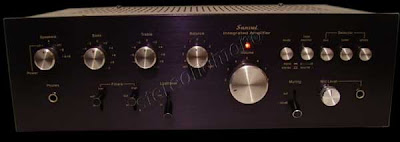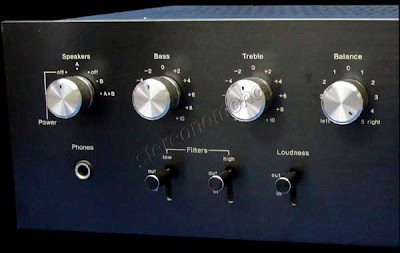
Sansui's high-quality AU/TU stereo components have become legends in their own time, representing the very best in high fidelity engineering and performance. And since Sansui is a respected audio-only electronics specialist in high fidelity, that's saying a lot about advanced, low-distortion circuitry, truly useful features and outstanding musical reproduction. To many high fidelity lovers, however, such expensive, specialized components often have been beyound economic reach. We.ve got good news for you. The two nwe AU integrated stereo amplifiers introduced here were created specificallt to solve this dilemma. Their quality lives up to the Sansui tradition in every way, as you will learn below. And their prices are well within reach of the average hi-fi budget.

Distortion 0,15% or less
Let's get right to the heart of hi-fi distortion. It hurts your ears. It hurts your music. And when you get right down to it, it's unnecessary! These amps have the stability, and more importantly, the circuit integrity, to eliminate practically all distortion. In the AU-4900 this translates to a power output rating of a continuous 35 watts per channel, min. RMS both channels driven, into 8 ohms from 40 to 20,000 Hz with no more than 0,15% THD. This is more than ample power for very clean musical reproduction from small to medium sized stereo speaker systems. And it's more than enough to give you pleasurable, ultra-low distortion sound at loud or soft listening levels.
Wide Dynamic Range
These special touches mean that a wide dynamic range for all signals passing through the inputs, equalizer, tone control and power output circuits to your speakers is maintained always. You hear all sounds at their proper levels - subtle and soft, loud and throbbing or in between as the artists and audio engineers intended.

Dual Plus/Minus Symmetrical Power Supplies.
How is this low-distortion/high power performance achieved? For one. Sansui has eschewed the use of hybrid power ICs choosing fully discrete component circuits instead. For another, the OCL-type power circuit has no coupling capacitor. Still another is the fact all circuits are supplied with plus/minus symmetrical voltages. And finally, the power sections themselves are built around the true complementary Darlington-connected design with a dual-transistor differential amplifier in the initail stage.
Mic Mixing Facility
Both AUs have what many stereo integrated amps lack - a mic mixing facility to let you blend microphone sounds with any program source for amplification through your speakers or for recording. It has its own mic level control next to the front-panel mic input jack to permit professional use.
Very Accurate Phono Equalizer.
Disc recordings are still regarded as the best sources for high fidelity music. But the low-level signals picked up by phono cartridges must be amplified with sufficient "headroom" to maintain fidelity. That's why both these AUs feature direct-coupled, lo-noise transistors in their equalizers coupled with precision elements to accept inputs up to 230 mV/220 mV (in reference to the 2,5 mV input) from your favorite cartridge, even if it has an exceptionally high output voltage. RIAA deviation is kept at a minimum for ideal dynamic range, and the signal-to-noise ratio is an unusually good 75 dB.

Protection Circuit
Power abnormalities can be very damaging to your speakers and the power transistors of any OCL-type amplifier. As in all Sansui amps, however, the AU-4900 and AU-3900 feature an elaborate power protection circuit to immediately disconnect your speakers and safeguard the transistors in the event of short circuits, etc. it uses an electronic relay instead of trouble-some fuses, and automatically restores itself when the danger has passed. Also since the dual plus/minus power supply system is used, you operate the power ON/OFF switch or other controls.
Additional High-Quality Features
Tone Control - circuit is the CR type with click-stop rotary controls (10 positions each) for Bass and Treble.
Audio Muting switch - instantly decreases output volume by 20 dB.
High Filter - eliminates record surface noise, tape hiss, etc. without harming musical content.
Low Filter - is provided to cut motor rumble and other low and sub-sonic noise.
Speaker Switch - lets you control two separate sets (A and B) of stereo speaker systems. It has four positions: OFF, A, B and A+B
Source Selectors - are the pushbutton type for easy selection of AUX, Tuner and phono program source inputs.
Tape Monitor - switch also a button is provided.
Other Features - include a front-panel headphone jack, a Loudness switch to compensate for highs and lows during low-level listening, a Mode switch with mono and stereo positions, two convenience AC Outlets )one "switched") and a large rear-panel ground peg.

Specifications AU-4900
Audio Section
Power Output (at rated distortion)
Music Power (IHF): 140 watts into 4 Ω at 1,000 Hz; 100 watts into 8 Ω at 1,000 Hz
Continuous RMS Power Both Channel Driven:
46 watts per channel into 4 Ω at 1 kHz
38 watts per channel into 8 Ω at 1 kHz
35 watts per channel into 8 Ω from 40 to 20, 000 Hz
Total Harmonic Distortion: less than 0,15% at rated power output
Intermodulation Distortion (70 Hz : 7,000 Hz = 4:1 SMPTE method): less than 0,2% at rated power output
Power bandwidth (IHF): 10 to 40,000 Hz at rated distortion
Load Impedance: 4 Ω to 16 Ω
Frequency Response (at 1 watt): 10 to 40,000 Hz, +0,5 dB -1,5 dB
RIAA Curve Deviation (Phono): 30 to 15,000 Hz; ±0,5 dB
Damping Factor: approx. 50 at 8 Ω load
Channel Separation (at rated output 1,000 Hz):
phono: better than 60 dB
Aux, Tuner, Tape Monitor: better than 65 dB
Hum and Noise (IHF):
Phono: better than 75 dB
Microphone: better than 65 dB
Aux, Tuner, Tape Monitor: better than 90 dB
Input Sensitivity / Impedance (1,000 Hz for rated output):
Phono: 2,5 mV/ 50 kΩ
Microphone: 2,5 mV/ 10 kΩ
AUX, Tuner: 130 mV/ 50 kΩ
Tape Playback (PIN): 130 mV/ 50 kΩ
Max. Input Capability (at 1,000 Hz, 0.2% THD):
Phono: 230 mV/50 kΩ
Recording Output:
Tape (PIN): 100 mv
Controls
Bass: +12 dB -12 dB at 50 Hz
Treble: +12 dB -12 dB at 15 kHz
Loudness: 10 dB at 50 Hz; 8 dB at 10 kHz
Filters
Low: -3 dB at 100 Hz (6 dB/oct.)
High: -3 dB at 7,000 Hz (6dB/oct.)
Muting (audio): 0 dB, -20 dB
General
AC Outles: switched Max. 100 watts unswitched total 150 watts
Semiconductors: 29 Transistors; 1 Zener Diode; 18 Diodes; 1 LED
Power Requirements: 100, 120, 220, 240 V 50/60 Hz
Power Consumption: 210 watts Max.; 90 watts rated
Dimensions (W x H x D): 400 x 120 x 240 mm (15¾" x 4¾x 9½")
Weight: 6,3 kg (14,8 lbs) net

Air Conditioner service center in Hyderabad | servicecentersinhyderabad.com
RispondiEliminahttp://www.servicecentersinhyderabad.com/air-conditioner-service-center-in-hyderabad.html
Air Conditioner Service Center in Hyderabad Contact No.+91-9885578328, 040-24547649. servicecentersinhyderabad provides Reliable Doorstep Repair Services. 100% Customer Satisfaction and Quality Services
Lo ha avuto mio fratello si sentiva una meraviglia poi mi sono comprato un sansui au d9 sansui non si smentisce mai
RispondiElimina